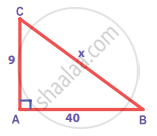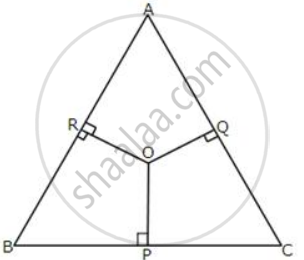Advertisements
Advertisements
प्रश्न
Find the unknown side in the following triangles
उत्तर
From ∆ABC, by Pythagoras theorem
BC2 = AB2 + AC2
Take AB2 + AC2
= 92 + 402
= 81 + 1600
= 1681
BC2 = AB2 + AC2
= 1681
= 412
BC2 = 412
⇒ BC = 41
∴ x = 41
APPEARS IN
संबंधित प्रश्न
In the given figure, ABC is a triangle in which ∠ABC < 90° and AD ⊥ BC. Prove that AC2 = AB2 + BC2 − 2BC.BD.

Prove that the sum of the squares of the diagonals of parallelogram is equal to the sum of the squares of its sides.
Find the side and perimeter of a square whose diagonal is 10 cm.
Digonals of parallelogram WXYZ intersect at point O. If OY =5, find WY.
In the following figure, OP, OQ, and OR are drawn perpendiculars to the sides BC, CA and AB respectively of triangle ABC.
Prove that: AR2 + BP2 + CQ2 = AQ2 + CP2 + BR2

If P and Q are the points on side CA and CB respectively of ΔABC, right angled at C, prove that (AQ2 + BP2 ) = (AB2 + PQ2)
In the given figure, angle ACB = 90° = angle ACD. If AB = 10 m, BC = 6 cm and AD = 17 cm, find :
(i) AC
(ii) CD

In a square PQRS of side 5 cm, A, B, C and D are points on sides PQ, QR, RS and SP respectively such as PA = PD = RB = RC = 2 cm. Prove that ABCD is a rectangle. Also, find the area and perimeter of the rectangle.
In a right angled triangle, if length of hypotenuse is 25 cm and height is 7 cm, then what is the length of its base?
In ΔABC, if DE || BC, AD = x, DB = x – 2, AE = x + 2 and EC = x – 1, then value of x is ______.
